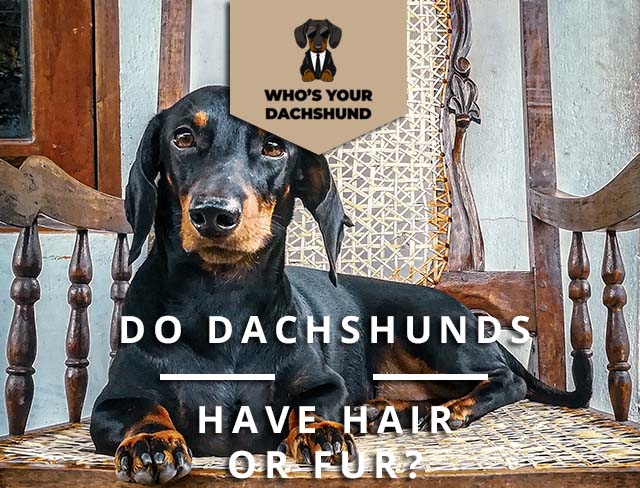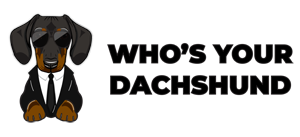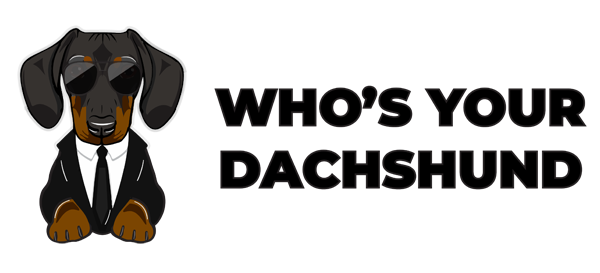
Dachshunds are covered in hair — not fur. Their body usually contains a mix of short and long hairs.
Dogs with longer coats have “fur,” dogs with shorter coats have “hair.” Dachshunds, which fall in the latter category, have hair — not fur.
Starting at the top of the head and working to the end of the tail, Dachshunds combine short and long hair.
But what determines whether a coat has fur or hair is the length of each strand. The strands that cover a hairless animal like a pig or snake are short, giving them their “hairless” name. Animals with fur, like the Dachshund, have strands that are longer than those covering hairless animals.
According to Dachshund Rescue of North America, both long-haired and wire-haired Dachshunds “have an undercoat of short, dense hairs for heat and protection from the cold. Unlike the long-haired varieties, the wire-haired has a topcoat of fine, longer hairs for insulation and to help the dog move more freely”.
Besides their fur coat, Dachshunds also have short guard hair covering their body. This guard hair is longer on Dachshunds than on most other breeds (and some animals), and it reaches its total growth around 4 to 5 months of age.
Dachshund Hair Types
Short-Haired Dachshund
Short-haired Dachshunds are a breed of very athletic and high energy. They also make great pets and can be good watchdogs.
Wire Haired Dachshund
Wire Haired Dachshunds are a popular choice for families who want an active dog that will also be happy to snuggle up on the couch. They have a distinctive, wiry coat that sheds little and does not tend to tangle.
Long Haired Dachshund
Long-haired Dachshunds have a coat that is very soft and luxurious to pet. They do still require regular grooming to prevent tangles from forming and mats from developing on the coat.
Difference Between Hair and Fur
The fur on a Dachshund is usually straight and long, though there are different varieties of this breed. There are also Dachshunds with short hair or wiry hair. The fur length does not affect the dog’s temperature regulation, but it can regulate its body temperature.
A Dachshund is also known as a “wiener dog” because of its short legs and long body. It acquired its name around the year 1850. The hair on their back is longer than the hair on its sides, and it also has longer whiskers than other breeds of dogs. They have short forelegs and long back legs, which helps explain why they can be great hunters with a low center of gravity. The Dachshund is known for its tenacity when it comes to hunting.
Are Dachshunds Hypoallergenic?
Dachshunds are a type of dog that many pet owners would like to have, but not if they suffer from allergies. This breed of animal is not hypoallergenic, which means that it is not recommended for people that have allergies to dogs. Allergies arise from pet dander, dead skin cells, and other substances that fall off an animal’s body.
Wire-haired Dachshunds
Wire-haired Dachshunds are one of the most popular types of Dachshunds. They have wire hair that grows to a length of one inch on the tail and longer on the ears, which gives them a long look when viewed from above. Typically, the longer the hair on their ears and tail, the higher the chances of developing health problems.
All Dachshunds are known to be excitable and energetic dogs. Wire-haired Dachshunds are even more temperament lively than smooth-coated Dachshunds due to them inheriting a great deal of energy from their ancestor, the greyhound dog breed.
Smooth Hair Dachshund
A dog breed that is small and long-bodied with short, smooth hair is easy to maintain. The smooth-haired Dachshund’s smooth coat does not require a large amount of grooming. However, as the dog ages and its coat becomes coarser, more grooming appears needed.
Smooth-haired Dachshunds are hypoallergenic, which means that they are less likely to cause allergic reactions in people who are highly sensitive to dogs. However, this is only true if they have never been bathed. If they are bathed regularly, they may develop a similar coat to the wire-haired Dachshund. It leads to an increase in allergic reactions to them.
Dachshunds & Allergies
Dachshunds and allergies come together in a perfect storm of misery. First, by the sheer nature of their elongated shape, Dachshunds are prone to developing skin problems and flea infestations. As a result, Dachshunds are at a higher risk of developing allergies than other breeds. And because skin problems and fleas plague them, they are at an even higher risk of developing allergies because they are exposed to more allergens like saliva and dirt than other breeds.
Dachshunds & Old Age
Unfortunately, Dachshunds also develop health problems as they age. The most common problems are musculoskeletal, respiratory, eyesight and hearing. People who get older are more prone to bone cancer, degenerative myelopathy (spinal disc disease), intervertebral disc disease (IVDD), and patellar luxation. They also suffer from cataracts, glaucoma, and canine deafness. Dachshunds should be vaccinated against distemper and hepatitis when they are puppies to avoid future problems.
Do Dachshunds Shed?
Yes, because, like many other long-haired breeds, Dachshunds have an undercoat (fluffy layer) of fur that sheds each year.
This coat comprises two layers of fur or hair: the longer topcoat and the short, dense undercoat. This double-layered coat protects from both heat and cold. The long hair on the Dachshund’s back helps to reflect heat away from its body, while the shorter hair on its underside helps it stay warm in cool weather.
How Much Do Dachshunds Shed?
Dachshunds are low-shedding dogs. They still shed, but not as significant as other breeds of dogs. It is essential to groom Dachshunds regularly so that you can keep their shedding to a minimum in the house.
Dachshunds are one of the most prone to hair loss breeds, and their coats will continue to thin as they age. Shedding is a natural process for all dogs, which aids in removing old dog hairs and keeps their coats shiny and healthy. Shedding is a good thing for your Dachshund as it means that their hair is growing, but it can be a nuisance for you.
Dachshunds are one of the most prone to hair loss breeds, and their coats will continue to thin as they age. Shedding is a natural process for all dogs, which aids in removing old dog hairs and keeps their coats shiny and healthy. Shedding is a good thing for your Dachshund as it means that their hair is growing, but it can be a nuisance for you.
Why Do Dogs Lose Their Fur?
A few things can cause dogs to lose their fur, including a form of alopecia known as CVID (canine vascular disease), hormonal problems, and stress. Dogs sometimes lose some or all of their hair when they have fleas.
How do I keep my Dachshund from losing his fur?
- Brush your Dachshund regularly
- Bathe him or her in non-toxic dog shampoo, such as oatmeal shampoo
- Wipe a little olive oil on their skin to help hydrate the fur and keep it silky smooth
- Keep them free of fleas and ticks by using a soothing topical flea/tick medication like Seresto, which works for eight months!
- When it gets too long, cut it short.
- Keep your Dachshund indoors during winter to avoid getting cold and losing its fur.
Grooming Your Dog
It is essential to groom your dog. Not only does regular grooming keep your dog healthy, but you can also learn a lot about your dog by looking into and grooming their fur. For example, if they are scratching their ears more than usual or have bald patches in their fur, they may show they are itchy or have fleas. Grooming also helps look for ticks and other pests.
Bathing Your Dog
One of the first things you can do if you notice itchy skin or that your dog has an odor is to bathe them. You should always consult your veterinarian before bathing your dog, especially if he is retired or has special needs. To bathe your dog, put their favorite shampoo in the water and make sure they have enough room in the tub to move around.
Get Fleas
Since fleas can carry many diseases, it is vital to keep them at bay. One way to do this is by giving your dog a monthly flea bath. You can also buy powders or sprays that will deter them indoors and keep them away from your couch. If you notice they have ticks on their fur, then you may need to get your dog checked out by the vet.
Brushing Your Dog
Brushing your dog’s fur is one of the best things you can do. Brushing allows the natural oils that are in their fur to come out and also removes any dead fur or pet hair. It will also help get rid of fleas that may be lurking in their fur. It would be beneficial to brush your dog regularly to get accustomed to it.
Dogs Without Hair
If you have a dog with unusual hair conditions, then here is what you can perform to help them.
- First, it is necessary to know what this unusual condition is. If you cannot find a name for the problem, then check in your vet’s book for other similar cases and see if any of those may describe your dog’s condition.
- Consider taking it to a vet before any drastic measures are taken. It will be a lot cheaper than taking it to the groomer. Once the condition has advanced, and it looks like it could be difficult, one can make an appointment for it.
- You can also go for the spray or powder on conditioner to address this problem. It is always best to use such shampoos as they are less likely to cause harm or irritations than other shampoos with no special treatment like Argan Oil Shampoo, which could dry out their skin and cause more problems.
- The other thing you can do to help a dog with unusual hair conditions is to check for fleas. It is the cause of such conditions as the dog’s hair stands up due to the irritation caused by the flea saliva.
The Difference Between Hair and Fur of Dachshund
The fur is an animal’s protective coat, such as the hair on a dog’s back. Hair is the type of tissue that covers most areas of your body.
Dachshunds are one of the most prone to hair loss breeds, and their coats will continue to thin as they age. Shedding is a natural process for all dogs, which aids in removing old dog hairs and keeps their coats shiny and healthy. Shedding is a good thing for your Dachshund as it means that their hair is growing, but it can be a nuisance for you.

